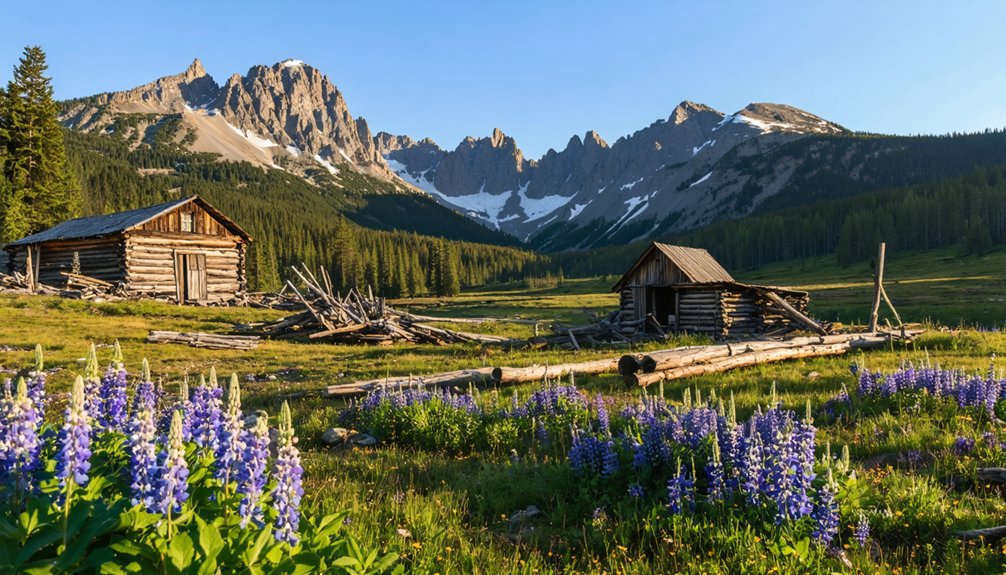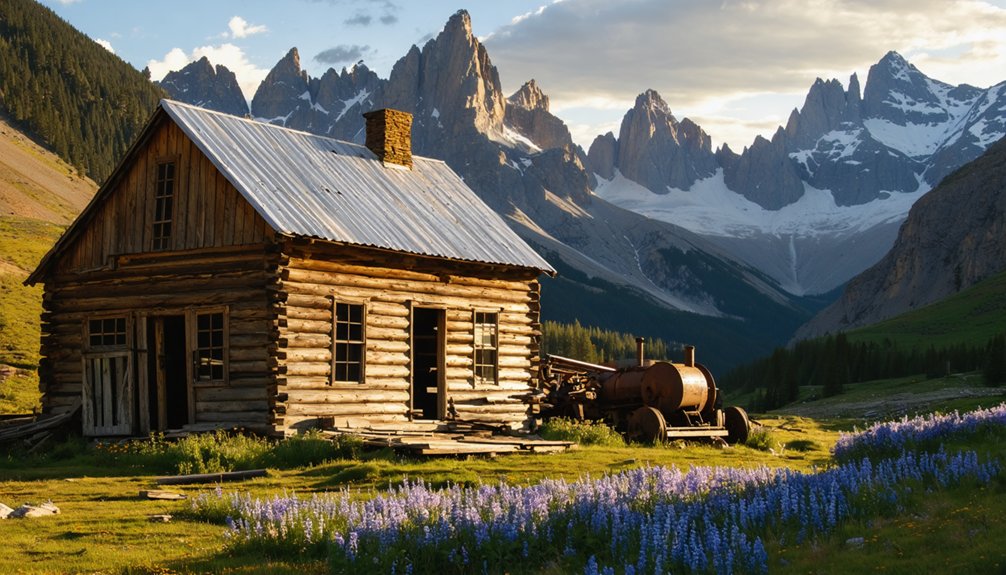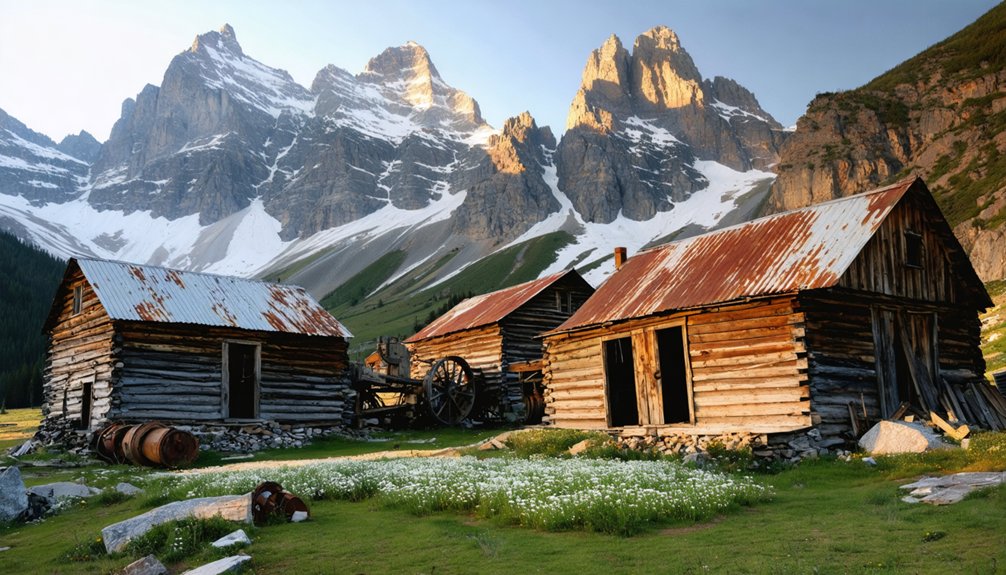You’ll find Washington Basin tucked into Idaho’s Boise Mountains, where prospectors first struck gold in 1862. The area quickly boomed with over 35,000 fortune seekers, becoming the Northwest’s premier mining region by 1863. Daily gold yields reached $600,000 in modern prices, while miners faced harsh conditions including severe winters and dangerous terrain. Today, preserved ghost town structures and abandoned mine shafts offer glimpses into Idaho’s rich mining heritage, with countless stories waiting beneath the surface.
Key Takeaways
- Washington Basin was a significant mining area contributing to Idaho’s 19% share of U.S. gold production between 1860-1866.
- Mining operations evolved from placer to lode mining, with tunnel systems extending over 13,000 feet by 1927.
- The Washington Mine produced 18,000-20,000 tons of ore averaging 1 ounce of gold per ton.
- Preserved structures and abandoned mine shafts serve as historical remnants of Idaho’s rich mining heritage.
- Access to the ghost town remains challenging, with roads often closed during winter months.
The Discovery of Gold in the Basin
When prospectors from Florence and Auburn, Oregon ventured into the Boise Basin in 1862, they made a discovery that would transform Idaho’s mining industry.
Three prospecting parties, led by Moses Splawn, H. Fogus, and George Grimes, joined forces as they carefully made their way through territory where Shoshoni Indians were known to be present.
On August 2, 1862, they struck gold near Boston Bar, in an area that would later become Centerville.
You’ll find this gold discovery particularly significant because it quickly established the Boise Basin as the Northwest’s premier mining region by 1863.
Within a year, over 35,000 fortune seekers had flooded into Idaho’s interior, making it one of the few states settled from west to east.
The basin’s pine and fir forests provided essential building materials for the mining camps that would soon dot the landscape.
The area became so productive that it yielded $600,000 worth of gold daily in modern prices, rivaling the output of other major mining districts.
Early Settlement and Population Growth
You’ll find Washington Basin’s first settlers arrived as prospectors seeking their fortunes after the discovery of gold deposits in the area’s mineral-rich terrain.
The Basin’s population swelled rapidly as word of the strikes spread, drawing thousands of miners who established temporary camps and more permanent structures near productive claims.
Like other mining communities in Silver Valley region, Washington Basin emerged as part of northern Idaho’s rich mining history. The area contributed to Idaho’s impressive 19% of U.S. gold production between 1860-1866.
Mining Draws Initial Settlers
The discovery of gold in Idaho’s Boise Basin during 1862 sparked a wave of migration that soon extended into the Washington Basin region. You’d find prospectors streaming in from Pacific coast states, staking claims under informal mining laws that allowed up to three claims per person.
The region’s extreme ruggedness created significant transportation logistics challenges for these early settlers. Much like medieval Florence, the area developed into a bustling economic center as precious metals drove trade and commerce. As miners established camps around promising sites, they’d face harsh winters and supply shortages while working to secure their grounds.
Claim disputes were typically settled by miner committees since formal government hadn’t yet reached the area. By 1863, as Idaho gained territorial status, you’d see these camps evolving into more structured communities, complete with merchants and service providers supporting the growing mining operations. With miners earning wages of $18 per day, the area attracted thousands seeking their fortune.
The basin’s economy expanded beyond just mining, though the industry remained the primary draw for settlers.
Population Surge During Rush
Discovery of gold at Pierce Creek in September 1860 ignited a dramatic population surge across Washington Basin and surrounding regions.
By winter 1861, you’d find over 1,000 transient miners in the Oro Fino Mining District alone, with numbers swelling to more than 5,000 by summer. The rush expanded rapidly to Newsome, Elk City, and Florence Basin.
The population demographics reflected a largely male, mobile workforce. The area was administered from Olympia Washington Territory during this period.
You’d see new settlements sprouting up along mining streams – Oro Fino, Pioneer City, Centreville, Placerville, and others.
Despite harsh winter conditions, between 2,000 and 3,000 people had already staked their claims in various districts by January 1862.
Steamboat lines on the Columbia River increased service to handle the massive influx of fortune-seekers, primarily from California.
Mining Operations and Techniques
Mining operations in Washington Basin began with simple placer techniques in 1862, as prospectors used pans, rockers, and sluices to recover gold from alluvial deposits.
As surface gold became scarce, miners shifted to lode mining, targeting rich quartz veins underground through drift and crosscut tunnels. The extensive tunnel system reached over 13,000 feet long by 1927.
You’d find miners using pick-and-shovel work combined with strategic blasting to extract ore from these veins, some containing spectacular grades of up to 396.3 oz/ton silver and 0.19 oz/ton gold.
They’d carefully sort high-grade material at the portal before sending it for processing. The Washington Mine proved particularly productive, yielding 18,000-20,000 tons of ore averaging 1 oz/ton gold in the late 1800s.
Most ore underwent crushing and milling locally before being shipped to regional smelters, including the Hecla Smelter in northern Idaho.
Life in a Booming Mining Town
If you’d lived in Washington Basin’s mining communities during the 1860s, you’d have faced primitive housing conditions, minimal sanitation, and constant health risks from the harsh environment.
You could’ve found entertainment and social connections at any of the 250 businesses in Idaho City, though the abundance of cheap whiskey often led to violent confrontations and general disorder. The city became a notoriously dangerous place where lawless behavior flourished among prospectors.
While some miners struck it rich, earning up to $2,000 in a good week, most residents struggled with the stark wealth inequality and challenging frontier conditions that defined daily life in these booming settlements. The severe winter of 1864-65 brought additional hardships when food became scarce and flour cost $1 per pound.
Daily Hardships and Challenges
Life in Washington Basin’s bustling mining town demanded extraordinary resilience from its inhabitants, who faced an array of daily challenges that tested both body and spirit.
You’d have to navigate treacherous granite mountains and dense forests just to reach your claim, while harsh winters brought constant threats of frostbite and illness. Your daily survival strategies included battling unstable ground conditions, insufficient water supplies, and poor sanitation that bred disease.
Community resilience was tested by fierce claim competition and the constant threat of financial ruin, despite potential weekly profits of $2,000. You’d struggle with respiratory problems from dust exposure, risk injuries from mining accidents, and face limited medical care.
The lawless environment meant you’d need to stay vigilant against theft, violence, and ethnic tensions while dealing with overcrowded, unsafe housing conditions.
Entertainment and Social Life
Despite the harsh realities of daily survival, Washington Basin’s social scene pulsed with vibrant energy and distinctive character. You’d find yourself drawn to the saloons, where whiskey flowed cheaper than water and miners gathered to unwind after grueling days in the mines.
These establishments became the heart of community life, offering both entertainment and refuge from the isolation of mining life. You wouldn’t lack for company in this bustling town, as community gatherings brought together a diverse mix of people from California, Missouri, and even China.
While formal entertainment options were limited, you’d join fellow miners in creating your own diversions through spontaneous celebrations and informal social networks. The booming economy, fueled by incredible gold yields, kept spirits high despite the occasional outbreaks of violence and social tensions.
Natural Disasters and Challenges

While Washington Basin’s remote location presented inherent challenges, the region’s natural disasters proved particularly devastating to its survival.
You’d have faced severe winter storms that dumped up to 58 inches of snow, making travel nearly impossible. The area’s steep terrain, combined with heavy rains and snowmelt, triggered dangerous mudslides that frequently blocked vital access routes like US 95.
In 1980, Mount St. Helens’ eruption blanketed the region with two inches of ash, creating concrete-like deposits that damaged soil and infrastructure.
Flooding posed another serious threat, especially during spring thaws when the nearby rivers would swell beyond their banks.
These environmental challenges, along with severe thunderstorms and devastating tornadoes in eastern Washington, made maintaining a stable community incredibly difficult.
Economic Rise and Decline
After Moses Splawn and George Grimes discovered gold in the Boise Basin on August 2, 1862, Washington Basin’s economic destiny changed forever.
Early Native American reports of gold “by the handful” sparked a rush that transformed wilderness into boomtown within months. The region’s economic resilience flourished as mining technology advanced, making Idaho City the Northwest’s largest settlement.
The boom cycle progressed through three distinct phases:
- Initial placer mining prosperity with over 50 miners by fall 1862
- Peak development with extensive infrastructure, including steamboat routes and supply chains
- Gradual decline as rich deposits depleted and miners sought opportunities elsewhere
Historic Buildings and Preservation

The architectural legacy of Washington Basin’s mining era remains visible through an impressive collection of preserved structures across multiple ghost towns.
Abandoned mine shafts and weathered buildings dot Washington Basin’s landscape, silent witnesses to Idaho’s rich mining heritage.
You’ll find log cabins and mining structures that reflect the region’s multicultural heritage, similar to those preserved in nearby Bayhorse, which came under state protection in 2009.
Historic preservation efforts mirror successful projects like Ed Jagels’ 1972 restoration of Silver City’s Idaho Hotel, showcasing the architectural significance of Idaho’s mining past.
While exploring these sites, you’ll need to navigate challenging access roads that are often closed during winter months.
Local communities and state initiatives continue working to maintain these historic treasures, balancing the need to preserve buildings against natural decay while managing tourism’s impact on these remote locations.
Modern Tourism and Heritage Sites
Modern visitors seeking authentic Old West experiences flock to Washington Basin and nearby Idaho ghost towns throughout the warmer months.
You’ll discover heritage preservation efforts that blend careful tourism management with opportunities for outdoor adventure and historical exploration.
- You can explore well-maintained trails that connect you to Bayhorse Lake’s fishing spots and picnic areas, while interpretive panels detail the region’s mining history.
- You’ll need to prepare adequately for remote locations by bringing supplies and navigation tools, as many sites are accessible only by foot or rugged vehicles.
- You can enhance your visit through guided tours that bring pioneer-era stories to life, or participate in wildlife observation and photography along the historic paths.
These sites seamlessly integrate natural beauty with preserved glimpses into America’s frontier past.
Frequently Asked Questions
What Indigenous Tribes Originally Inhabited the Boise Basin Area?
You’ll find the Shoshone Tribe dominated the Boise Basin, sharing the land with Bannock peoples, while the Nez Perce visited for trading. The Northern Paiute and Sheepeaters also inhabited these territories.
How Did Miners Communicate With Families Back Home During the Rush?
You’d rely heavily on letter writing through postal services and express companies, while using telegram services when available. Stage lines transported your messages between mining camps and major settlements.
What Happened to the Chinese Immigrant Population After the Gold Rush?
Like leaves scattered by harsh winds, you’d see Idaho’s Chinese population dwindle from 4,000 to under 900 by 1910, driven out by Labor Struggles, Chinese Exclusion, and violent expulsions.
Were There Any Famous Outlaws or Lawmen Associated With Idaho City?
You’ll find Idaho City’s outlaw legends centered on Henry Plummer, who served as sheriff while secretly leading the “Innocents” gang, and Dave Updyke, whose lawman stories ended with vigilantes hanging him in 1866.
What Role Did Women Play in the Early Development of Boise Basin?
You’ll find women’s contributions in Boise Basin were crucial, running businesses, establishing social organizations, and managing essential services. They operated stores, restaurants, laundries, and shaped civic development through women’s clubs and leadership roles.
References
- https://www.youtube.com/watch?v=hjQ9plwJeYg
- https://www.legendsofamerica.com/idaho-city-idaho/
- https://outerrealmz.com/the-amazing-ghost-towns-of-central-idaho/
- https://www.youtube.com/watch?v=Lv0AMQg0hlI
- https://en.wikipedia.org/wiki/Florence
- https://history.idaho.gov/wp-content/uploads/0198.pdf
- http://www.ghosttownsusa.com/ruby2.htm
- https://idahocityhistoricalfoundation.org/?page_id=1126
- https://www.goldprospectors.org/News/ArtMID/406/ArticleID/658/Gold-Mining-in-Idaho-Then-Now
- https://history.idaho.gov/wp-content/uploads/2018/08/0009.pdf



